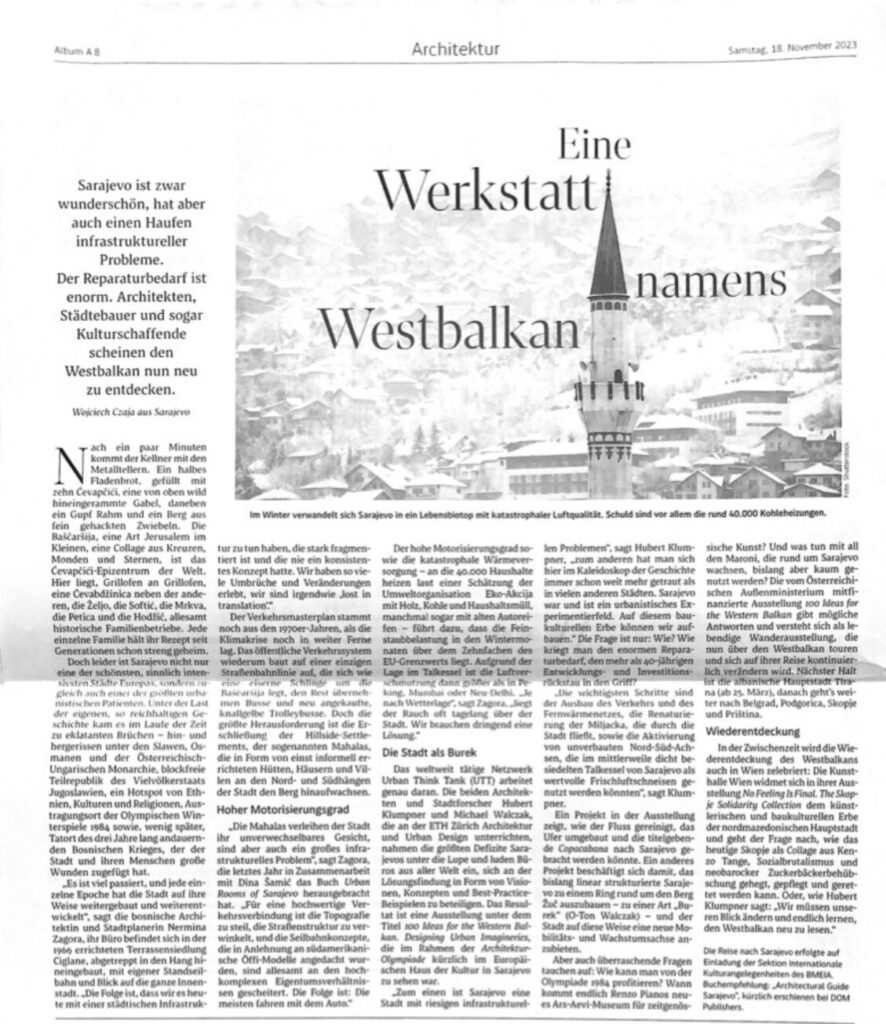TOWN PLANNING
A WORKSHOP CALLED WESTERN BALKANS
Architects, urban planners and even cultural agents are rediscovering Sarajevo. A visit
(Wojciech Czaja, November 19, 2023, 3:00 p.m)
“Depending on the weather, the smoke often hangs over the city for days. We urgently need a solution.”
THE CITY AS BUREK
The global Urban-Think Tank (Utt_next) is working on exactly this. The two architects and urban researchers Hubert Klumpner and Michael Walczak, who also teach architecture and urban design at ETH Zürich, took a close look at Sarajevo’s biggest deficits, and invited offices from all over the world to help find solutions in the form of visions, concepts and best practices – Practical project examples and Prototypes. The result is an exhibition entitled “100 Ideas for the Western Balkans”. Designing Urban Imaginaries, which was recently shown at the European House of Culture in Sarajevo as part of the Architecture Olympics.
“On the one hand, Sarajevo is a city with huge infrastructural problems,” says Hubert Klumpner, “on the other hand, in the kaleidoscope of history, people have always dared to do far more here than in many other cities. Sarajevo was and is a field of urban experimentation. In this building culture We can build a legacy.” The question is how? How do you get the enormous need for repairs and the more than 40-year development and investment backlog under control?
LOTS OF GOOD IDEAS
“The most important steps are the expansion of transport and the district heating network, the renaturation of the Miljacka river, which flows through the city, and the activation of unobstructed north-south axes, which could be used as valuable fresh air corridors in the now densely populated Sarajevo basin.” says Klumpner.
One project in the exhibition shows how the river could be cleaned, the bank rebuilt and an urban beach, brought to Sarajevo. Another project is concerned with expanding the previously linearly structured Sarajevo into a ring around Mount Žuč – a kind of “Burek” – and in this way offering the city a new mobility and growth axis.
But surprising questions also arise: How can one benefit from the 1984 Olympics. When will Piano’s new ARS AEVI museum for contemporary art finally come? And what to do with all the chestnuts that grow around Sarajevo but are unused? The exhibition 100 Ideas for the Western Balkans, co-financed by the Austrian Foreign Ministry, provides possible answers and is seen as a living traveling exhibition that will now tour across the Western Balkans and will continuously change on its journey. The next stop is the Albanian capital Tirana (from March 25th), then we continue to Belgrade, Podgorica, Skopje and Pristina.
…Or as Hubert Klumpner says: “We have to change our perspective and finally learn to read the Western Balkans anew.”
Translation in English by Google translate, edited by HK. Translation published on Urban-Think Tank Next.

Leave a Reply